Figure 10.1 e-Learning Anaesthesia (http://www.e-LA.org.uk/) provides four key resources.
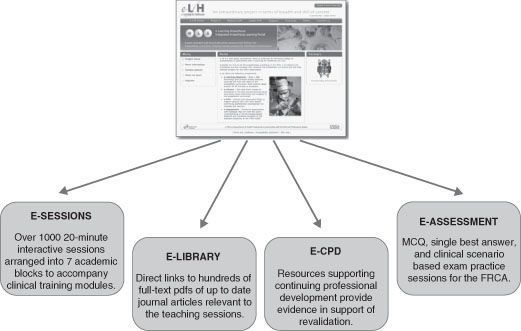
e-Learning Anaesthesia
Key points
The e-Learning Anaesthesia project (e-LA) is a joint initiative between the Royal College of Anaesthetists (RCoA) and English Department of Health (DoH) intended primarily to support the first two years of specialist training in anaesthesia leading towards the Fellowship (FRCA) Examination Part 1. It also provides a learning and reference resource for trainers that can be integrated effectively into local teaching programmes. E-Learning Anaesthesia has been designed as an ‘online’ package comprising interactive e-learning sessions, examination practice sessions, end of module self-assessments and an extensive e-library archive of portable document format (pdf) articles made available through close cooperation with several of the anaesthetic journals and publishing houses.
The rationale behind e-Learning Anaesthesia
There are estimated to be 12 600 anaesthetists currently practising in the UK’s National Health Service (NHS). Of these, 4500 are trainees. Traditionally, anaesthetic trainees have learned their art from a combination of practical guidance gained in a supernumerary capacity accompanying consultant anaesthetists in their day-to-day work, supplemented by self-directed reference to textbooks. Over time, this has allowed the acquisition of sufficient knowledge and experience to pass the RCoA examinations. However, a number of observations and changes that have occurred in the last decade call into question the future validity of this relatively unstructured approach to learning:
The e-Learning Anaesthesia project
In response to these drivers, the e-LA initiative was conceived as an entirely new resource for learning to be made available via the Internet to all UK anaesthetists. At its heart is a course comprising 1000 e-learning sessions covering the knowledge base required of the RCoA at the fellowship examinations. Each session is designed to take approximately 20 min to complete and addresses clearly defined learning objectives mapped to the curriculum published by the RCoA. The material can be viewed at any time, day or night. The 1000 e-Sessions are supported by access to an extensive e-library of carefully selected peer-reviewed journal articles targeted at the anaesthetic curriculum and a bank of e-assessment exercises using questions set carefully to match the FRCA exam standard (Figure 10.1).
Figure 10.1 e-Learning Anaesthesia (http://www.e-LA.org.uk/) provides four key resources.

e-Learning Anaesthesia is aimed primarily at trainees in their first two years of specialist training but is also of value as an educational resource to those engaged in teaching at a local level and to fully qualified specialists wishing to maintain their knowledge base and professional development. The e-LA FRCA curriculum is presented on-line broken down into seven academic modules or blocks of related subjects (Figure 10.2). Each block was formulated to match the academic requirements of clinical placements in the first two years of the specialist training programme. e-Learning Anaesthesia has been designed to operate synergistically with, rather than replace, existing teaching methods, and to provide a framework for local teaching and clear guidance about the standard and depth of knowledge expected of candidates at professional FRCA examinations. All content is accessed via a Learning Management System, enabling tracking of use and the creation of national and bespoke learning paths through the resources.
Figure 10.2 Block structure for the e-LA curriculum.
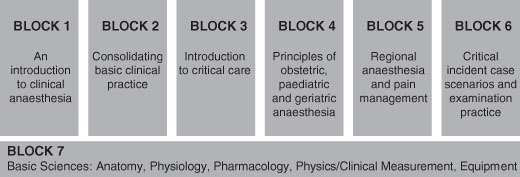
e-Sessions
Each session takes around 20 min to complete and addresses clearly defined learning objectives mapped to the RCoA curriculum. Within each session, information is presented in a standardised series of carefully structured screens or pages (Table 10.1) (Figure 10.3). The visual arrangement of information within the page is varied to suit different learning styles. Use of tabbed pages allows presentation of the same material at varying levels of complexity to suit different levels of pre-existing knowledge, the overall aim being to maximise conceptual understanding rather than simple acquisition of facts. Many sessions incorporate information derived from clinical tests such as X-rays, ultrasound scans and biochemical analyses. Any material that can be reproduced electronically can be added to a session as an ‘asset’. This adds significantly to the learning experience. Sessions are peppered with interactive exercises designed to encourage reflective learning. These take a variety of forms, from simple true/false questions to complex drag and drop interactions that require users to label figures or accurately identify items or processes in their correct order. All knowledge checks are accompanied by detailed explanations. Thus, the e-learning session has evolved to incorporate the structure of a well-written textbook and the insight of an expert lecture, without losing the interaction of a small group tutorial.
Table 10.1 Standard e-LA session structure.
| 1. Title page and brief description of session content 2. Learning objectives for the session and any prerequisites 3. Introduction or background to the subject 4. Learning material (presented as a mixture of text, images, video, audio, and flash animations) 5. Interactive knowledge checks – questions or case-based discussions (multiple true/false questions, single best answer questions, drag-and-drop questions) all instantaneously marked and accompanied by feedback based on the user’s responses 6. Summary page revisits the learning objectives for the session and suggests further reading |
Figure 10.3 Tabbed pages from an e-learning session about spinal anaesthesia. Note the inclusion of video demonstrating the entire procedure being performed on a real patient.
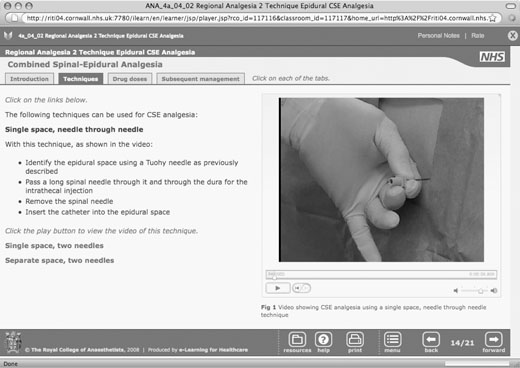
e-Library
e-Learning Anaesthesia sessions are supported by free and direct access to an extensive e-library of >1000 carefully selected peer-reviewed journal articles, all cross-referenced and mapped to the anaesthetic curriculum. Five journals and two medical publishing houses have pledged to make a significant fraction of their published scientific papers and reviews available through e-LA (Figure 10.4). The entire e-library may also be browsed for specific subjects and the catalogue searched by keywords. The project is ongoing and we anticipate that other journal publishers will agree to the inclusion of their published material in the catalogue. If so, the e-library has the potential to become the most extensive collection of indexed electronic publications ever to be linked directly to the anaesthetic curriculum.
Figure 10.4 Burt & Durbridge, “Management of cardiac disease in pregnancy” screenshot reproduced by kind permission of Oxford University Press (2009): Continuing Education in Anaesthesia, Critical Care & Pain, 9 (2), 44–4.
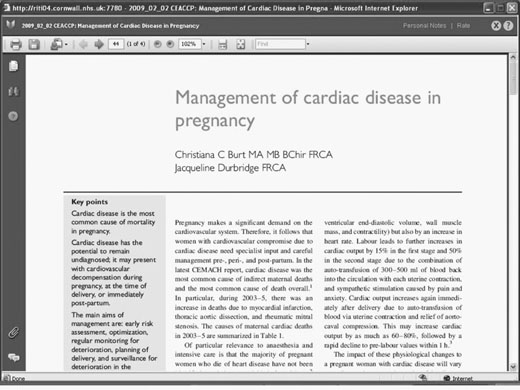
e-Assessment
Interactive formative assessments are an integral part of all e-sessions, but trainees are always hungry for more formalised examination practice. A bank of 57 e-assessment exercises has been established, using questions that test understanding of the knowledge-based sessions whilst carefully introducing students to the standard expected at the FRCA examination. These assessments are voluntary, but can be reviewed later with a local tutor (Figure 10.5).
Figure 10.5 e-Assessment session comprising 10 five-part multiple choice questions on pharmacology drawn from the RCoA FRCA question bank. The exam paper is electronically marked before answers and explanations are revealed. The e-assessment exam practice report is automatically stored on the Learning Management System but can also be reviewed later by the trainee and their local College Tutor.
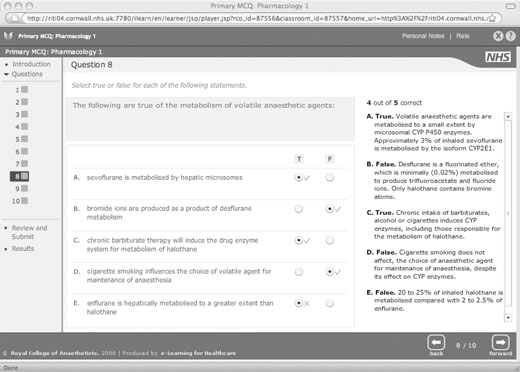
e-CPD (Continuing Professional Development)
In January 2009 the editorial Board of the British Journal of Anaesthesia agreed that e-Learning Anaesthesia would host specialist articles and multiple choice questions drawn from the journal and the RCoA’s CPD publication Continuing Education in Anaesthesia, Critical Care, and Pain. For each edition of the journal, users of e-LA are able to review each article followed by a set of related questions. The multiple choice questions are initially presented as they would be in an examination – without answers, explanation or feedback. Once the user is satisfied with the responses they have made, the entire question set is submitted electronically for marking. The pass mark is set at 80%, as it is in the paper version of the journal. Answers and explanations are then available for review, but the score achieved has been recorded as evidence of successful specialist CPD activity. This is much more effective than the historic route of simply collecting points for attendance at a meeting.
Registration for, and uptake of, e-Learning Anaesthesia
Successful uptake of e-LA has been dependent upon two main factors: widespread registration of both trainees and their trainers, and subsequent use of the online material. Each registrant has been given an individual password-protected account that records progress through the curriculum. The initial target of 400 College Tutors and 2000 trainees was very quickly achieved within the first year. By June 2010, >3800 trainees had registered for access. This represents 85% of all trainees in the UK on the seven-year anaesthetic training programme. Although the first phase e-learning sessions are aimed at the first two years of the training programme, uptake data demonstrates the value of the e-learning resource to trainees and specialists who are not in the primary target audience. Overall, 74% of UK anaesthetists are now registered users of e-LA (Figure 10.6). Further analysis of trainee uptake of e-LA has revealed widespread adoption throughout the UK and has demonstrated no particular regional bias.
Figure 10.6 Registered e-Learning Anaesthesia users: April 2007–July 2011.
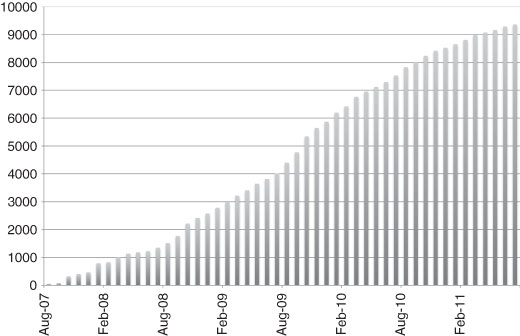
The Learning Management System also collects anonymised aggregate data about the number of e-sessions accessed and the length of time spent learning online. There has been remarkable agreement between the aggregate time spent on-line and the number of sessions accessed, suggesting that these two indicators are equally valid as assessors of usage. Peaks in online activity are observed around the time of the Primary FRCA examinations, supporting the hypothesis that this resource is perceived by trainees to be relevant and useful in preparation for the FRCA exam.
Feedback from users
Feedback from users has always been considered vital to the development process of the e-LA project and was sought via several routes:
In terms of functionality, the majority of respondents scored the e-LA system as ‘excellent’ or ‘good’ with regard to: speed of login; speed of page loading; technical reliability; clarity; appropriate use of multimedia. Problems were highlighted with the design and layout of the navigational aspects of the Learning Management System that made it difficult for users to find specific sessions. This problem has been highlighted as a priority when the project is transferred to a new Learning Management System in 2012. More than 90% of respondents rated the educational quality of the content of the sessions ‘excellent’ or ‘good’, and the majority were impressed with the relevance of the material, breakdown of the curriculum into appropriate sessions, and the use of assessments within the sessions to test knowledge (Figure 10.7). Eighteen per cent of respondents were not happy with the depth of detail in some sessions. Further sub-analysis of this group suggested that the comments were made by more experienced trainees referring to sessions in the introductory block that were aimed primarily at the novice anaesthetist in their first three months of training.
Figure 10.7 User ratings of the educational value of e-Learning Anaesthesia.
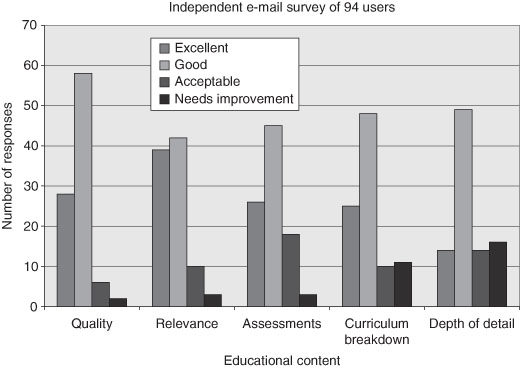
Summary
To date, e-LA has attracted 9632 registered users who have collectively completed 250 000 online teaching sessions representing 135 000 h of e-learning activity. It has proved to be a highly successful interactive and engaging, web-based, postgraduate e-learning solution that has been embraced enthusiastically by both trainees and trainers as a resource that can be relied upon to present educational material to a nationally approved College standard.
‘It is hard to imagine an initiative which will have greater capacity to deliver education in anaesthesia, critical care and pain management, or to improve the quality and safety of patient care, than the NHS e-learning anaesthesia project’ (Sir Peter Simpson, Past President, RCoA).